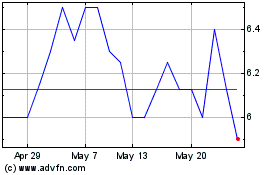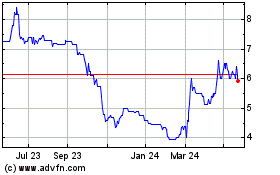TIDM1SN
RNS Number : 9323L
First Tin PLC
11 September 2023
11 September 2023
First Tin Plc
("First Tin" or "the Company")
Crushing Testwork Confirms Significant Upgrading Effect for Both
High-grade and Low-grade Mineralisation at Taronga Tin Project
First Tin PLC ("First Tin"), a tin development company with
advanced, low capex projects in Germany and Australia, is pleased
to report that results of the crushing pre-concentration testwork
on bulk samples from its Australian Taronga project from an adit
through the North Pit mineralisation have now been received and
assessed.
The results confirm First Tin's hypothesis that due to the
selective breakage along veins (Figures 1 to 4), liberation of
cassiterite can be achieved simply by coarse crushing to 12mm and
screening at 2.8mm. The plus 2.8mm fraction is a discard while the
minus 2.8mm fraction goes through the processing plant, thus the
mass going through the plant is significantly decreased and the tin
grade significantly increased.
Two samples have now been tested, one grading 0.18% Sn (high
grade) and the other grading 0.10% Sn (low grade).
Results are:
-- High-grade sample (0.18% Sn)
o Sub 2.8mm size fraction contains 85% of the tin in 54% of the
mass
o This fraction has been upgraded from 0.18% Sn to 0.30%Sn
o Plus 2.8mm size fraction contains 15% of the tin in 46% of the
mass
-- Low-grade sample (0.10% Sn)
o Sub 2.8mm size fraction contains 84% of the tin in 58% of the
mass
o This fraction has been upgraded from 0.10% Sn to 0.15% Sn
o Plus 2.8mm size fraction contains 16% of the tin in 43% of the
mass
The samples were initially jaw crushed on site to around 45mm
and were subsequently re-crushed in the ALS Metallurgy laboratory
in Perth to 12mm using a simulated conventional three-stage
crushing circuit.
This crushed sample was screened at 2.8mm with the oversize and
then put through a single pass vertical impact crusher (VSI) to
scavenge any tin (cassiterite) not already liberated. This product
was again screened at 2.8mm and the minus 2.8mm fraction
re-combined with the minus 2.8mm fraction from the conventional
crushing. The plus 2.8mm material is considered as waste and is
sent directly to a waste rock emplacement facility.
The results confirm the premise that the cassiterite (SnO(2) -
tin ore mineral) is easily liberated at a coarse crush size. The
grade of material is increased by 50-67% and the mass is reduced to
54-58% of the original mass, making the rest of the processing
facility smaller than would otherwise be required and the starting
grade higher.
After the crush stage, the remainder of the plant involves
simple gravity separation. Gravity separation testwork on the
-2.8mm product of the crushing is currently underway and overall
results will be announced shortly.
The first stage of the gravity separation involves screening at
0.4mm with the oversize (60%) going to jigs and the undersize (40%)
to spirals.
Results for jigging of the high-grade sample show that 27% of
the total mined ore can be rejected, with the accepts being
upgraded to a 1.21% Sn concentrate.
Results for rougher spiral separation of the high-grade sample
show that 20% of the total mined ore can be separated to a middling
product grading 0.17% Sn for further treatment, with the accepts
being upgraded to a 4.57% Sn concentrate.
Putting this data together from the crush, jig and spiral
testwork from the 0.18% sample then, prior to any grinding or
additional gravity separation testwork:
-- 73% of the mass containing 21% of the tin can be rejected
-- 7% of the mass containing 64% of the tin can be concentrated to a product grading 1.94% Sn (pre-concentrate)
-- 20% of the mass containing 15% of the tin grading 0.17% Sn
reports to a middling product requiring further processing via
grinding and gravity concentration to produce a pre-concentrate
-- In total, 79% of the tin in 27% of the mass grading 0.63% Sn
is available for further processing
This simple front end and low-cost beneficiation process is
unique to the Taronga asset and means that the capital and
operating costs of any processing plant will be relatively low for
the size of operation under consideration.
First Tin CEO Thomas Buenger said: "We are very pleased that we
have now confirmed our previous hypothesis that the mineralisation
at Taronga can be simply and cheaply upgraded at a very early stage
in the processing circuit using a simple coarse crushing and
screening technique followed by simple jigs and spirals. It is
particularly encouraging that even toward the lower end of the
grades we are likely to mine, this large upgrading effect still
works at the coarse crushing stage.
To be able to significantly increase the grade of material after
simple crushing, jigging and rougher spirals from 0.18% to 0.63% is
a major milestone in turning the Taronga deposit into a viable
mining proposition, as is the significant reduction in tonnage
which will mean lower opex and capex."
The project is owned by First Tin's 100% owned Australian
subsidiary, Taronga Mines Pty Ltd ("TMPL").
Figure 1: Quartz-Cassiterite Veins in Outcrop
Figure 2: Quartz-Cassiterite Vein Showing Breakage Along Vein,
Exposing Cassiterite
Figure 3: Coarse Cassiterite on Vein Surface Showing Easy
Liberation
Figure 4: Coarse Cassiterite in Vein in Drill Core
Enquiries:
First Tin Via SEC Newgate below
Thomas Buenger - Chief Executive
Officer
Arlington Group Asset Management
Limited (Financial Advisor
and Joint Broker)
Simon Catt 020 7389 5016
WH Ireland Limited (Joint
Broker)
Harry Ansell 020 7220 1670
SEC Newgate (Financial Communications)
Elisabeth Cowell / Molly FirstTin@secnewgate.co.uk
Gretton
Notes to Editors
First Tin is an ethical, reliable, and sustainable tin
production company led by a team of renowned tin specialists. The
Company is focused on becoming a tin supplier in conflict-free, low
political risk jurisdictions through the rapid development of high
value, low capex tin assets in Germany and Australia.
Tin is a critical metal, vital in any plan to decarbonise and
electrify the world, yet Europe has very little supply. Rising
demand, together with shortages, is expected to lead tin to
experience sustained deficit markets for the foreseeable future.
Its assets have been de-risked significantly, with extensive work
undertaken to date.
First Tin's goal is to use best-in-class environmental standards
to bring two tin mines into production in three years, providing
provenance of supply to support the current global clean energy and
technological revolutions.
This information is provided by RNS, the news service of the
London Stock Exchange. RNS is approved by the Financial Conduct
Authority to act as a Primary Information Provider in the United
Kingdom. Terms and conditions relating to the use and distribution
of this information may apply. For further information, please
contact rns@lseg.com or visit www.rns.com.
RNS may use your IP address to confirm compliance with the terms
and conditions, to analyse how you engage with the information
contained in this communication, and to share such analysis on an
anonymised basis with others as part of our commercial services.
For further information about how RNS and the London Stock Exchange
use the personal data you provide us, please see our Privacy
Policy.
END
DRLURAKRONUKARR
(END) Dow Jones Newswires
September 11, 2023 02:00 ET (06:00 GMT)
First Tin (LSE:1SN)
Historical Stock Chart
From Jan 2025 to Feb 2025

First Tin (LSE:1SN)
Historical Stock Chart
From Feb 2024 to Feb 2025
